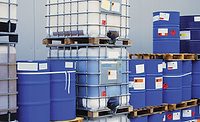Powder Coating Provides Maximum Flexibility for Harley-Davidson

Until late 1994, Harley-Davidson’s Milwaukee power train division used liquid paint on the engines and transmissions it manufactured. But there were problems. “One of the big reasons that steered us toward powder was stability,” explains Ken Ellis, senior manufacturing engineer and process lead.
That wasn’t all. “There were cost, performance and environmental advantages of powder as well,” Ellis says. “When we liquid painted our components, many of them had to be painted after machining, which was much more costly.” Harley-Davidson now powder coats all the components of its drive train at a powder coating facility in Milwaukee that services two manufacturing plants. The facility has a dual line conveyor system with a capacity of approximately 10,000 parts per day. For each line, there is an inverted enclosed track system. Handling parts pass through six stages: pretreatment washer, a dry off oven and a cool down chamber, then an environmental room, a cure oven and final cool down chambers. Parts are powder coated black or silver using a combination of automatic and manual guns. According to Ellis, the plant produces parts with a wide variety of shapes and sizes.
The company has committed its future success to powder coating. “We’re scheduled to have a second powder coating plant online in June,” Ellis reports. The new plant will be similar to the original, but it will be a single line facility. The new facility will improve Harley’s ability to meet the demand for its product.
The new plant also gives Harley-Davidson the chance to increase its efficiency even more. Ellis says, “We’re looking for some line speed improvements with the new facility. Also, we are doing some technical improvements, more automation, better layout and greater flexibility. We will have the latest technology that is out there right now.”
There is one particular technological enhancement that the company is especially proud of. “We’ve gone to automatic feed pumps to control our wash line stages, which is something we’ve been doing for awhile. However, we now download that data into a statistical process control (SPC) package.” He continued, “Every 15 minutes, we download information from our wash line, whether it be temperature, pH or concentration, into the SPC package, so at any remote location in the plant, you can watch how the wash line is performing. We get a much better picture of what is happening in our wash line at any given time. It gives us confidence in the performance of the end product.”
With the influx of data, the rate of defects has dramatically decreased, which saves the company time and money. Ellis hopes to present Harley-Davidson and automated SPC as a case study at the national Powder Coating show in September.
Outside of Milwaukee, the company uses powder coating for the clear coat on its tanks and fenders; motorcycle frames are powder coated at plants in York, PA, and Kansas City, MO.
And who knows what lies ahead? The company has begun powder coating motorcycle parts that have been traditionally chromed or polished. These bikes are winning customers in Europe, though Ellis guesses that the U.S. market will stick with chrome.
Looking for a reprint of this article?
From high-res PDFs to custom plaques, order your copy today!




